
Polyvagal Theory, developed by Dr. Stephen Porges, provides an intricate understanding of the autonomic nervous system, focusing particularly on the vagus nerve and its two branches: the dorsal vagus and the ventral vagus. This theory helps us see our nervous system’s responses not as signs of dysfunction but as evidence of our body’s remarkable strength and adaptability. The ventral vagus, which Porges describes as our “home base,” is crucial for social engagement and feelings of safety, promoting calm states and social connection. However, the sympathetic system mobilizes us to confront challenges, and even the dorsal vagal branch, though it can lead to shutdown, serves as a protective mechanism when other options seem impossible. The issue arises when our nervous system becomes inflexible and struggles to move fluidly between these states. By understanding Polyvagal Theory, we can better appreciate the complex ways our nervous system operates and work towards cultivating greater resilience and adaptability in our lives, transforming patterns of stress and disconnection into opportunities for growth and connection.1
Being Human is Uncomfortable
When the stress response is activated, our nervous system’s light switch dimmer revs up to ensure our safety, triggering a cascade of physiological and psychological effects. These heightened neural and neuroendocrine responses can sometimes become overloaded. To cope, the dorsal vagal system activates, which numbs the sensations we experience, giving our body and mind a temporary break. While this can provide relief, it often feels lonely and isolating. To return to our home base, the ventral vagal state, we must process the sensations and emotions experienced in the sympathetic state. This journey can be challenging, causing us to feel stuck between the dorsal and sympathetic states as we experience the inherent discomfort of being human (1).
Being embodied is our most empowered state of being because it allows us to be fully present and engaged with the diverse array of sensations, thoughts, and emotions we experience. Through meditation and mindfulness practices, we can strengthen our ventral vagal tone, which is crucial for activating the parasympathetic nervous system. This system, often referred to as the “rest and digest” mode, helps us remain calm, centered, and resilient in the face of life’s challenges.
A New Baseline
Initially, our “home base” might not be a state of relaxation. Many of us have felt the weight of stress for years, whether it stems from the coping mechanisms we’ve developed over time, our best efforts to navigate life’s challenges, or from various external influences like our environment and economic circumstances. Our earliest experiences with caregiving profoundly shape our nervous system, either fostering strong ventral vagal wiring for connection and calm or leading to adaptations in sympathetic or dorsal vagal modes to soothe unmet needs.2
These experiences have often led our sympathetic (fight or flight) or dorsal vagal (shutdown) states to become our norm. However, with the power of non-judgmental awareness, compassion, and consistent daily practice, we can gradually shift this baseline. Through mindful practices, we can gently guide ourselves back to a state of calm and presence, slowly transforming our response to stress and nurturing a more empowered way of being.
As we engage in regular mindfulness and meditation, we begin to cultivate a stronger ventral vagal tone. This shift allows us to more frequently and easily access the parasympathetic nervous system, making calm and centeredness our new home base. This transformation may happen slowly, but with persistence, we can rewire our nervous system. Little by little, through gentle practice and self-compassion, we can return to our bodies and establish a state of empowered embodiment. This new norm enables us to handle life’s turbulence with greater ease and resilience.3
- Porges, S. W. (2011). The polyvagal theory: Neurophysiological foundations of emotions, attachment, communication, and self-regulation. Norton & Company. ↩︎
- Dana, D. A. (2018). The Polyvagal Theory in Therapy: Engaging the Rhythm of Regulation (Illustrated Edition). W. W. Norton & Company. ↩︎
- Dana, D. A., & Porges, S. W. (2018). The Polyvagal Theory in Therapy: Engaging the Rhythm of Regulation. W. W. Norton & Company. ↩︎